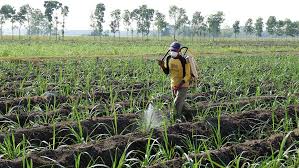In this article, the basic principles of weed control and the various wee management methods of weeds control are discussed. The cultural weed management system and its various elements are explained.
Martin, H. J. etal. (1963) reported that, weeds cost the American farmers $5 billion annually in crop losses and in the expense of keeping them under control. Therefore, understanding the principles of weeds control and various methods of controlling weeds are preconditions for successful execution of weed control programme.
Chemical, biological and integrated methods of weed control are also treated in such a way that the strength, suitability and limitations of each method of weed controlled were stressed.
Weed control refers to those actions that seek to restrict the spread of weeds and destroy or reduce their population in a given location.
Weed eradication refers to the complete removal of all weeds and their Propagules from a habitat. Weed eradication is difficult to achieve and is uneconomical in most situations.
There are situations when problems posed by a noxious weed becomes so overwhelming that eradication is a desirable long term goal. For example,Strigaasiatica and Strigahermonthica are parasitic weeds of several cereal crops throughout the tropics. These weeds do not respond to weed control technologies available at present to farmers in the region. An eradication program is seen as a desirable long term goal for these weed species.
Factors Necessitating Weed Eradication Program
Other weed control measures are ineffective.
Weeds have many buried seeds that cannot be controlled by conventional practices.
The infested field is small.
Benefits from eradication outweigh those of the alternative methods for coping with the weed.
Weed Management
This is the ability to manipulate weeds so that they do not seriously interfere with the growth, development and economic yield of crops and animals. The major components of weed management are preventive weed control, cultural control, and biological and chemical weed control.
Principles of Weed Control
The weed should be killed before it has a chance to produce seeds. For this reason, land that is left fallow should be ploughed at intervals in order to kill weeds before they produce seeds.
Weeding should occur before the crop begins to suffer from the competition of the weeds.
Perennial weeds should be attacked at the beginning of the rainy season when the amount of reserved food present in them is minimal.
The cost of controlling weeds on a crop should be weighed against the expected loss in yield and quality if the weeds are not controlled.
Read Also : Biological Methods of Weed Control Guide

Crops should be properly spaced so that when the crops are fully grown the ground is completely covered, thus depriving the weeds of sun light, therefore can only grow slowly.
Factors Affecting the Effectiveness of Weed Control
The type of crop grown.
Timing of the weeding operation.
Nature of the weed problem.
Method of weed control.
Types of weeds to be controlled.
Cost of the operation and availability of cash resources.
Environmental condition before, during, and after the time of operation.
Read Also : Feed and Nutrition Management for Cattle
